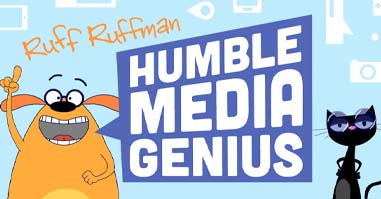Home — Learning Resources — Middle School — Digital Literacy
Middle School Digital Literacy
Ruff Ruffman: Humble Media Genius
 RUFF RUFFMAN: HUMBLE MEDIA GENIUS addresses how kids use technology, and allows students and teachers to explore four topics with original animation and interactivity: texting, sharing photographs, conducting searches, and finding an appropriate balance of technology and media use.
RUFF RUFFMAN: HUMBLE MEDIA GENIUS addresses how kids use technology, and allows students and teachers to explore four topics with original animation and interactivity: texting, sharing photographs, conducting searches, and finding an appropriate balance of technology and media use.
> Go to Ruff Ruffman: Humble Media Genius
Other Resources
This interactive resource uses animations, faux websites and a quiz to help students learn how to evaluate the reliability of information found on the Internet.
In this interactive lesson, students learn strategies for improving their media literacy and will be able to identify both credible and non-credible news sources.
In this interactive lesson, students examine primary source media—specifically, news footage, over the last five decades. For a final assignment, students select footage and write an essay or blog post that contains their analysis.
This collection, includes videos, blog articles, student handouts, lesson plans, and tip sheets for families, and helps students identify, analyze, and investigate the news and information they get from online sources.
Find tips from Common Sense Education to help students assess the accuracy of what’s on the web and determine whether the information found is true, false, or somewhere in between.
This video from Common Sense Education provides useful guidance on using reverse image search on Google.
Use this lesson plan from Common Sense Education to teach students how to “test before you trust” the sites and information found on the Web.
Use this lesson plan from Common Sense Education to teach students about being media savvy when using the web so that the results are reliable, safe, and factual.
Use these videos by Student Reporting Labs (SRL) to discuss media literacy tips with students. SRL lesson plans, assignment prompts and instruction tools facilitate critical thinking, problem-solving, teamwork, and communication skills.
 RUFF RUFFMAN: HUMBLE MEDIA GENIUS addresses how kids use technology, and allows students and teachers to explore four topics with original animation and interactivity: texting, sharing photographs, conducting searches, and finding an appropriate balance of technology and media use.
RUFF RUFFMAN: HUMBLE MEDIA GENIUS addresses how kids use technology, and allows students and teachers to explore four topics with original animation and interactivity: texting, sharing photographs, conducting searches, and finding an appropriate balance of technology and media use.